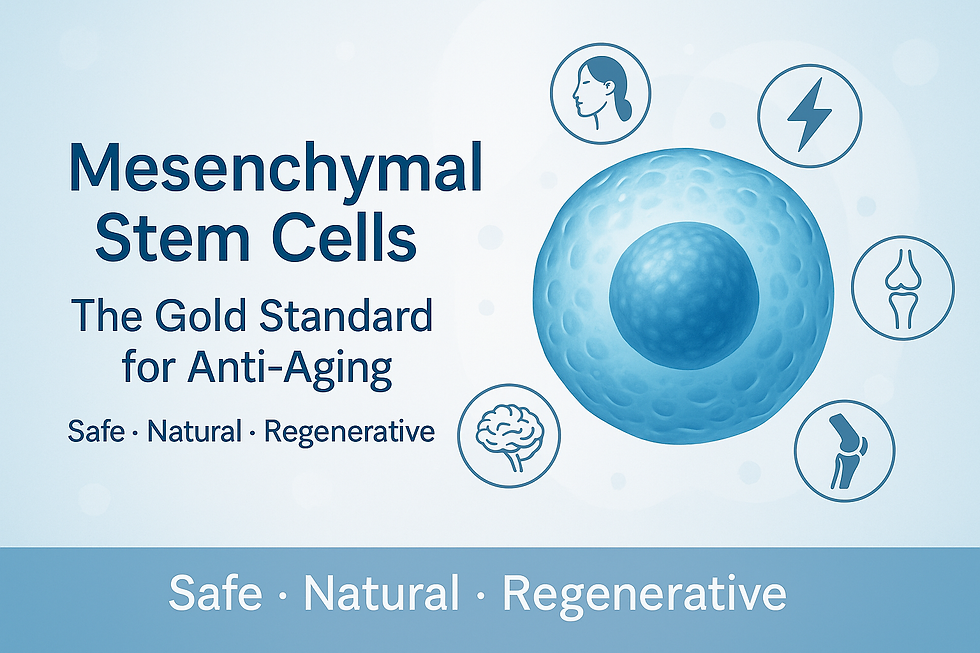How Stem Cells Help with Tissue Repair and Regeneration
- Revival Clinic Team

- Aug 3
- 4 min read

The body has an incredible natural ability to heal. However, with age or chronic disease, this ability slows down — sometimes significantly. This is where stem cell therapy offers a promising solution. By activating and enhancing the body's natural repair mechanisms, stem cells have been shown to support the regeneration of damaged tissue, reduce inflammation, and improve long-term function.
At Revival Clinic Bangkok, we specialize in mesenchymal stem cell therapy (MSC) that is safe, effective, and ethically sourced — serving patients from Singapore, UAE, Australia, and other parts of the world. In this post, we’ll explain how stem cells support tissue repair and regeneration based on the latest scientific research.
What Are Stem Cells and Why Are They Important?
Stem cells are undifferentiated cells with the ability to:
Self-renew (make copies of themselves)
Differentiate into specialized cells (e.g., skin, muscle, nerve, or cartilage)
Signal nearby cells to begin repair and regeneration
This makes them essential for tissue healing, growth, and homeostasis throughout life.
Mesenchymal stem cells (MSCs), in particular, are known for their:
Anti-inflammatory effects
Immune modulation
Secretion of growth factors and cytokines
Regeneration of musculoskeletal and connective tissue
According to Stem Cells Translational Medicine (2020), MSCs are especially effective in treating degenerative joint diseases, tissue injury, and autoimmune inflammation due to their ability to home in on damaged areas and promote repair.
How Do Stem Cells Support Tissue Repair?
Stem cells contribute to repair through two major mechanisms:
1. Cell Replacement
Stem cells can differentiate into the specific types of cells needed to replace damaged tissue. For example:
In cartilage damage, MSCs may become chondrocytes
In soft tissue injuries, they may become fibroblasts or muscle cells
This process is especially important in orthopedics, skin rejuvenation, and sports medicine.
2. Paracrine Signaling (Secretome Effect)
More commonly, stem cells exert their effects by secreting bioactive molecules, such as:
Cytokines
Growth factors (e.g., VEGF, TGF-β, IGF)
Exosomes
These signals:
Stimulate resident tissue to repair itself
Increase blood flow and oxygen to the site
Reduce inflammation and scarring
Promote the survival of existing cells under stress
A 2021 review in Cells emphasized that paracrine signaling is the primary driver of stem-cell-induced healing in many clinical applications.
What Conditions Benefit Most from Tissue Regeneration?
The most common conditions treated at Revival Clinic using stem cell therapy for regeneration include:
Osteoarthritis and joint degeneration→ Stimulates cartilage repair, reduces joint inflammation
Tendon or ligament injuries→ Encourages regrowth of connective tissue, ideal for sports injuries
Skin aging and texture loss→ Increases collagen and elasticity, improves tone and hydration
Post-surgical recovery→ Supports faster tissue healing and reduced scar formation
Post-COVID or autoimmune inflammation→ Helps regenerate lung tissue and restore energy levels
How Revival Clinic Ensures Effective Regenerative Therapy
Our clinic prioritizes:
Xeno-free mesenchymal stem cells sourced from healthy umbilical cord donors
Lab-expanded cells processed in sterile, quality-controlled environments
Doctor-supervised protocols, with personalized treatment plans
High international safety standards and transparent lab documentation
We treat patients from around the world who seek reliable, evidence-based therapy in a luxury setting.
Discover more at our stem cell therapy page.https://www.revivalclinicbangkok.com/stemcelltreatmentbangkok
What Makes Tissue Regeneration with MSCs So Promising?
Here’s what sets stem cell therapy apart from traditional treatment options:
Feature | Traditional Treatment | Stem Cell Therapy |
Pain relief | Often requires medication | Natural anti-inflammatory effects |
Tissue regeneration | Limited or none | Actively promotes regeneration |
Side effects | Moderate (esp. with drugs) | Low (flu-like symptoms only) |
Long-term benefits | Temporary symptom relief | Potential disease-modifying effect |
This is why many of our patients choose stem cell therapy to avoid surgery, reduce medication dependency, or slow degeneration.
FAQ
Q: Will the injected stem cells become new tissue?
A: In some cases, yes — but most of the benefit comes from the paracrine (signaling) effect, which stimulates your body’s own healing response.
Q: How long does it take to see tissue repair?
A: Some patients report improvement within weeks; full effects are typically seen in 1 to 3 months.
Q: Can stem cells heal completely damaged tissue?
A: Stem cells improve healing and function, but they may not reverse damage completely — especially in end-stage conditions. Early treatment shows the best outcomes.
Ready to Begin Your Regenerative Journey?
Whether you're seeking to recover from injury, reverse signs of aging, or prevent further tissue degeneration, Revival Clinic offers safe, effective regenerative care using premium stem cell therapy.
Contact us today to schedule your consultation and explore how regenerative therapy can support your health goals.
References
Ranganath, S. H., et al. (2012). Harnessing the mesenchymal stem cell secretome for the treatment of cardiovascular disease. Cell Stem Cell, 10(3), 244–258. https://doi.org/10.1016/j.stem.2012.02.005
Bernardo, M. E., & Fibbe, W. E. (2013). Mesenchymal stromal cells: Sensors and switchers of inflammation. Cell Stem Cell, 13(4), 392–402. https://doi.org/10.1016/j.stem.2013.09.006
Caplan, A. I., & Correa, D. (2011). The MSC: An injury drugstore. Cell Stem Cell, 9(1), 11–15. https://doi.org/10.1016/j.stem.2011.06.008
Zhang, Y., et al. (2021). The paracrine effect of stem cells in tissue regeneration and repair. Cells, 10(9), 2437. https://doi.org/10.3390/cells10092437



Comments